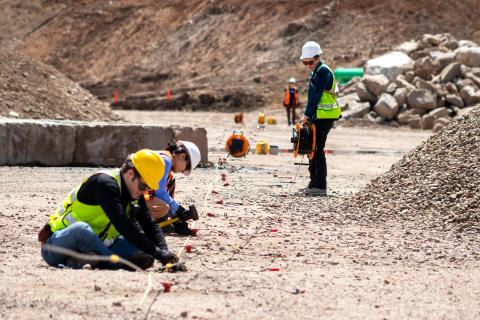All Categories
Featured
Table of Contents
Geophysical Survey in East Cannington Western Australia 2021
(PREM)., and the borders in between layers of the mantle are constant with phase shifts.

This makes plate tectonics possible. Schematic of Earth's magnetosphere. The solar wind circulations from delegated right. If a planet's electromagnetic field is strong enough, its interaction with the solar wind forms a magnetosphere. Early area probes drawn up the gross measurements of the Earth's electromagnetic field, which extends about 10 Earth radii towards the Sun.
Inside the magnetosphere, there are reasonably dense regions of solar wind particles called the Van Allen radiation belts. Geophysical measurements are generally at a particular time and location.
What Is Geophysics? in Shenton Park Oz 2021
, combines huge collaborates and the local gravity vector to get geodetic collaborates. This technique just offers the position in 2 coordinates and is more hard to utilize than GPS.
Relative positions of two or more points can be identified utilizing very-long-baseline interferometry. Gravity measurements entered into geodesy since they were required to associated measurements at the surface area of the Earth to the reference coordinate system. Gravity measurements on land can be used gravimeters released either on the surface area or in helicopter flyovers.
Water level can likewise be measured by satellites using radar altimetry, adding to a more precise geoid. In 2002, NASA released the Gravity Recovery and Environment Experiment (GRACE), in which two twin satellites map variations in Earth's gravity field by making measurements of the range between the 2 satellites using GPS and a microwave ranging system. Satellites in space have actually made it possible to collect information from not just the noticeable light region, but in other areas of the electromagnetic spectrum. The planets can be identified by their force fields: gravity and their electromagnetic fields, which are studied through geophysics and space physics. Measuring the modifications in acceleration experienced by spacecraft as they orbit has permitted great details of the gravity fields of the planets to be mapped.
Geophysics Jobs in Palmyra Western Australia 2020

Considering that geophysics is worried about the shape of the Earth, and by extension the mapping of functions around and in the world, geophysical measurements consist of high precision GPS measurements. These measurements are processed to increase their accuracy through differential GPS processing. When the geophysical measurements have been processed and inverted, the analyzed outcomes are outlined utilizing GIS.
Many geophysics companies have actually created internal geophysics programs that pre-date Arc, GIS and Geo, Soft in order to meet the visualization requirements of a geophysical dataset. Exploration geophysics is used geophysics that frequently utilizes remote picking up platforms such as; satellites, aircraft, ships, boats, rovers, drones, borehole noticing equipment, and seismic receivers.
Aeromagnetic data (airplane gathered magnetic data) collected using traditional fixed-wing airplane platforms need to be corrected for electromagnetic eddy currents that are produced as the airplane moves through Earth's magnetic field. There are likewise corrections associated with changes in determined prospective field strength as the Earth turns, as the Earth orbits the Sun, and as the moon orbits the Earth.
Geophysics in Helena Valley Oz 2021
Signal processing involves the correction of time-series data for unwanted noise or mistakes presented by the measurement platform, such as airplane vibrations in gravity data. It also includes the reduction of sources of sound, such as diurnal corrections in magnetic information. In seismic information, electromagnetic information, and gravity information, processing continues after error corrections to include computational geophysics which lead to the last analysis of the geophysical information into a geological analysis of the geophysical measurements Geophysics became a different discipline just in the 19th century, from the crossway of physical geography, geology, astronomy, meteorology, and physics.
The magnetic compass existed in China back as far as the fourth century BC. It was used as much for feng shui as for navigation on land. It was not until good steel needles might be created that compasses were utilized for navigation at sea; before that, they might not keep their magnetism enough time to be useful.
By taking a look at which of 8 toads had the ball, one might identify the instructions of the earthquake. It was 1571 years prior to the first style for a seismoscope was published in Europe, by Jean de la Hautefeuille. It was never developed. Among the publications that marked the start of contemporary science was William Gilbert's (1600 ), a report of a series of careful experiments in magnetism.
Geophysics, Engineering Geophysics And Applied ... in Hocking Oz 2023
Dietmar; Sdrolias, Maria; Gaina, Carmen; Roest, Walter R. (April 2008). "Age, spreading out rates, and spreading out asymmetry of the world's ocean crust". Geochemistry, Geophysics, Geosystems. 9 (4 ): Q04006. Bibcode:2008 GGG ... 9. 4006M. doi:10. 1029/2007GC001743. S2CID 15960331. "Earth's Inconstant Electromagnetic field". science@nasa. National Aeronautics and Space Administration. 29 December 2003. Obtained 13 November 2018.
Runcorn, S.K, (editor-in-chief), 1967, International dictionary of geophysics:. Pergamon, Oxford, 2 volumes, 1,728 pp., 730 fig Geophysics, 1970, Encyclopaedia Britannica, Vol. Introduction to seismology (2nd ed.).
Latest Posts
Geophysical Survey Methods in Western Australia 2021
Geophysicist Salary in Wembley Downs Aus 2021
Bsc Geophysics in Safety Bay WA 2023